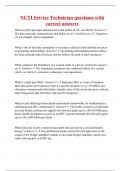Exam (elaborations)
NCTI Service Technician questions with correct answers
- Course
- Institution
What are three principle characteristics that define an AC waveform? Answer The three principle characteristics that define an AC waveform are: (1) frequency; (2) wavelength; and (3) amplitude. What is one of the basic principles of resistance reflected in the familiar practices of grounding and...
[Show more]



